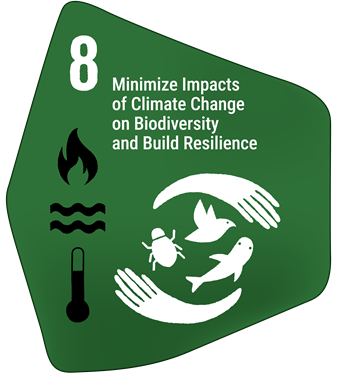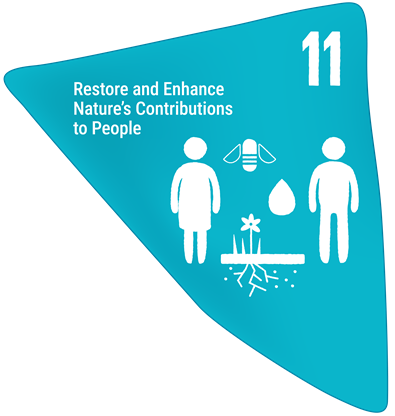Error message
Notice: Undefined property: Drupal\redirect\EventSubscriber\RouteNormalizerRequestSubscriber::$aliasManager in Drupal\redirect\EventSubscriber\RouteNormalizerRequestSubscriber->onKernelRequestRedirect() (line 118 of modules/contrib/redirect/src/EventSubscriber/RouteNormalizerRequestSubscriber.php). Tyler Lagalo, Unsplash
Tyler Lagalo, Unsplash
International Day for Disaster Risk Reduction--13 October 2024
The linkages between biodiversity conservation and disaster risk reduction are well established. Wetlands, forests, and mangroves, for example, absorb floodwaters, stabilize soils, and protect coastlines. Healthy ecosystems underpinned by thriving biodiversity act as a bulwark against disasters. The biodiversity conservation and disaster risk reduction nexus can be addressed through the synergistic implementation of the Kunming-Montreal Global Biodiversity Framework (KMGBF) and the Sendai Framework for Disaster Risk Reduction.
Adopted in 2022 under the Convention on Biological Diversity (CBD), the KMGBF is the world’s masterplan to halt and reverse biodiversity loss through 23 action targets that must be achieved by 2030. The KMGBF includes important elements pertaining to disaster risk reduction and reducing the impacts of hazards. The Sendai Framework, adopted in 2015, aims to reduce vulnerability to natural hazards by strengthening resilience and adaptive capacities, particularly in communities at the frontline of climate impacts. In a commendable initiative, the UN Office for Disaster Risk Reduction (UNDRR) has recently issued guidance on integrating disaster risk reduction in National Biodiversity Strategies and Action Plans (NBSAPs), the principal vehicles of implementation of the CBD and the KMGBF.
The scale of transformational change required for the implementation of the KMGBF demands a whole-of-society endeavor that includes young people. Youth are not only the leaders of tomorrow but also powerful agents of change today. We count on them to raise awareness, advocate for sustainable practices, and push for policies that prioritize biodiversity conservation and sustainable use while bolstering disaster risk reduction.
Education underpins social and ecological resilience in the face of environmental shocks. Ramping up the implementation of Sustainable Development Goal SDG-4 on education can empower youth and give them the tools to deploy leadership and innovation for a disaster-free future. By giving them the means to unlock their full potential, education empowers young people to the benefit of society as a whole. In many disaster-prone regions, women and young people are among the most vulnerable. In such contexts, education and literacy reduce vulnerability and exposure, thus preventing natural hazards from becoming disasters.
Conversant with information technology and able to receive and act on timely weather reports or emergency-response instructions, youth can assume leadership roles in the field of disaster preparedness and response within their families and communities.
More Information:
Parties to the CBD are submitting national targets reflecting the KMGBF
Related Targets in The Kunming-Montreal Global Biodiversity Framework
Minimize the impact of climate change and ocean acidification on biodiversity and increase its resilience through mitigation, adaptation, and disaster risk reduction actions, including through nature-based solutions and/or ecosystem-based approaches, while minimizing negative and fostering positive impacts of climate action on biodiversity.
Why is this target important?
Climate change is one of the main direct drivers of biodiversity loss. In addition to climate change, rising atmospheric carbon dioxide concentrations have also resulted in ocean acidification. Various mitigation, adaptation and disaster risk reduction measures, including nature-based solutions and/or ecosystem-based approaches, have the potential to increase the resilience of ecosystems and human livelihoods to the impacts of climate change, including reducing emissions from deforestation and other land-use changes, and by enhancing carbon sinks. These approaches can also deliver numerous social, economic and environmental co-benefits.
Links to other elements of the Biodiversity Plan and other frameworks and processes.
- Actions to reach Target 8 should take into account all of the considerations for implementation identified in section C of the Kunming-Montreal Global Biodiversity Framework.
- Progress towards Target 8 will help to reach goals A and B of the Kunming-Montreal Global Biodiversity Framework. Progress towards this target could also help to reach targets 2, 3, 4, 10, 11, and 12. Conversely, progress towards targets 1, 10, 14, 19, 20, 21, 22 and 23 would facilitate progress towards this target.
- Target 8 addresses issues previously addressed in Aichi Biodiversity Target 10.
- Elements of Target 8 are also addressed in the targets of the Sustainable Development Goals, including targets 13.1, 13.2 and 14.3.
- Target 8 is also relevant to work being undertaken under the Paris Agreement under the UNFCCC, as well as the Sendai Framework for Disaster Risk Reduction.

Restore, maintain and enhance nature’s contributions to people, including ecosystem functions and services, such as regulation of air, water, and climate, soil health, pollination and reduction of disease risk, as well as protection from natural hazards and disasters, through nature-based solutions and/or ecosystem-based approaches for the benefit of all people and nature.
Why is this target important?
Nature’s contributions to people, a concept similar to and inclusive of ecosystem services, refers to all the contributions from biodiversity to people’s well-being or quality of life. These contributions take various forms, including material contributions, regulating services and other non-material contributions including spiritually and culturally. As a result of the ongoing decline of biodiversity, nature’s contributions to people are also in decline, with serious implications for human well-being and social cohesion. The restoration, maintenance and enhancement of nature’s contributions to people provides an important rational for the conservation and sustainable use of biodiversity.
Links to other elements of the Biodiversity Plan and other frameworks and processes.
- ns to reach Target 11 should take into account all of the considerations for implementation identified in section C of the Kunming-Montreal Global Biodiversity Framework.
- Progress towards this target will support the attainment of goals A and B of the Kunming-Montreal Global Biodiversity Framework. Progress towards this target will be facilitated through the actions taken to reach the other targets of the Global Biodiversity Framework, in particular those targets addressing the direct drivers of biodiversity, namely targets help to reach targets 2, 3, 5, 6, 7, 8, 9, 10 and 12.
- Elements of Target 11 were previously addressed under Aichi Biodiversity Target 14.
- Elements of Target 11 are also addressed in the targets of the Sustainable Development Goals, including targets 1.5 and 15.4
